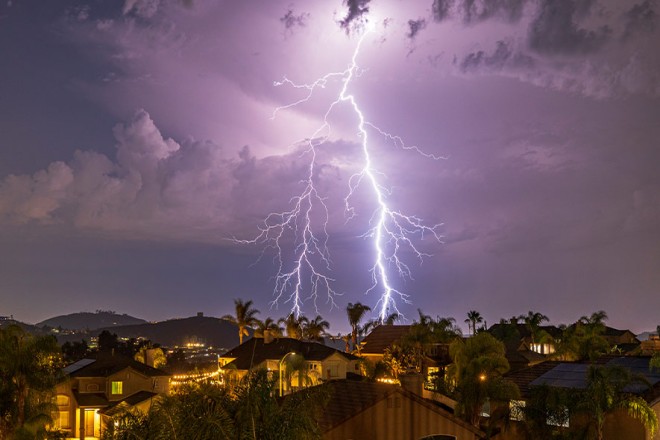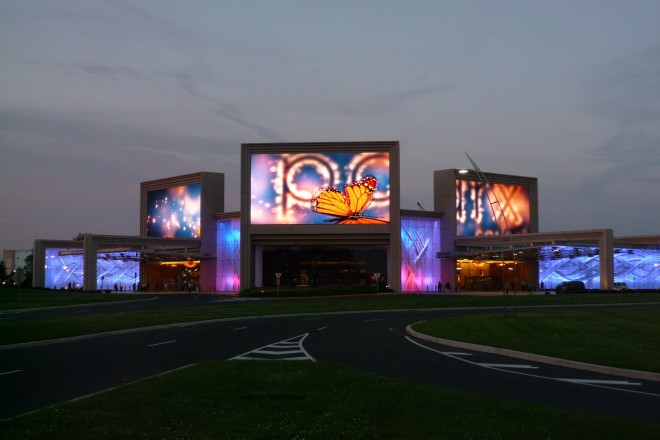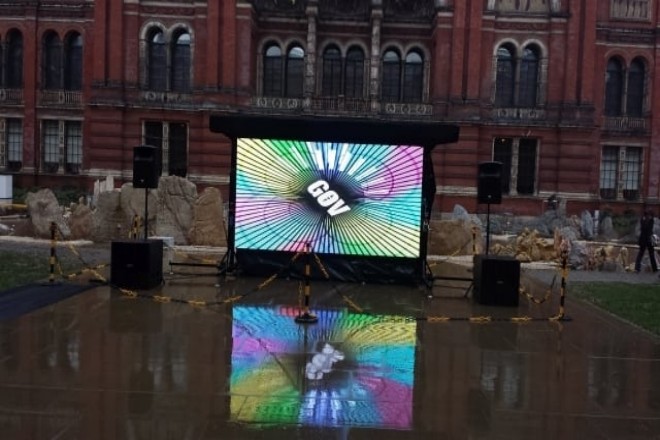مقدمة

As an important part of modern cities, شاشات عرض LED خارجية not only beautify urban landscapes but also efficiently transmit information.
However, in areas with frequent thunderstorms, these display screens face serious threats of lightning disasters.
Therefore, it is particularly important to explore and implement effective protection measures to ensure the safe operation of outdoor LED display screens during thunderstorm seasons.
1. Protection of outdoor LED display screens against direct lightning
In terms of protection against direct lightning strikes, installing lightning rods is a vital link. The following is a detailed introduction to the selection, specifications, and installation location selection principles of lightning rods:
1). Types and specifications of lightning rods:
There are various types of lightning rods, including single-needle lightning rods, lightning protection net systems, etc. The specific selection should be determined according to the characteristics of the protected object (such as height, function, surrounding environment, etc.).
In terms of specifications, it should be ensured that the lightning rod can withstand the expected lightning current impact and has good conductivity.
2). Principles for selecting the installation location:
- Highest point installation principle:
The lightning rod or equipment should be installed at the highest point of the building to ensure that it can attract lightning and avoid lightning strikes in other unprotected areas.
In general, the installation height of the lightning rod should be 3~5 meters higher than the highest point of the protected object.
- Calculation of protection range:
The protection range of the lightning rod can be calculated using the broken line method and the rolling ball method. Based on the height of the building and the installation height of the lightning rod, its protection radius is reasonably calculated to ensure that the protected building or equipment is fully covered.
- Multi-level protection:
For complex buildings, such as high-rise buildings, towers, or industrial facilities, a single lightning rod may not provide comprehensive protection.
At this time, it is necessary to design a multi-level and multi-point lightning protection system according to the height and structure of the building, as well as install multiple lightning rods and down conductor systems.
3). Installation requirements:
The lightning rod must be tightly connected to the down conductor, and the down conductor should be made of materials with good electrical conductivity, such as copper or aluminum, to ensure that the lightning current can be quickly and safely introduced into the ground.
Down conductors should be arranged in straight lines as much as possible, with fewer sharp turns and corners to reduce arc discharge caused by increased resistance at the bends during the flow of lightning current.
The support structure of the lightning rod must be stable and reliable, especially when the lightning rod is installed on a high-rise building or tower, its stability and wind resistance must be ensured.
The grounding of the lightning rod is a key link in guiding its lightning current into the ground, and the design of the grounding system determines the effectiveness of the lightning protection device. The grounding resistance should be as low as possible to ensure that the lightning current can be smoothly discharged into the ground.
2. What protective measures are needed for the steel structure of the outdoor LED display

1). Equipotential connection: Hand in hand, everyone is safe
Imagine that when lightning strikes the ground or a building near the outdoor LED display, it will find a path to release energy.
If there is a potential difference between the steel structure and the outer shell of the display, lightning may cause damage through this difference. To avoid this, we need to connect the steel structure and the outer shell of the display “hand in hand” so that they are at the same potential level.
The specific operation is to use conductive materials (such as copper tape or wire) to connect the various parts of the steel structure to the outer shell of the display.
In this way, when lightning strikes, both the steel structure and the display housing will meet the lightning at the same potential, thereby reducing the damage caused by the potential difference.
2). Grounding: Give lightning a good place to go
Grounding is a key step to ensure that lightning can be safely released underground. Imagine if lightning finds an “exit” on the steel structure, but it cannot enter the underground smoothly, then lightning will run around and cause damage to surrounding equipment.
To ensure that lightning can be discharged smoothly, we need to:
- Measure grounding resistance:
Use a professional grounding resistance tester to measure the resistance of the current grounding system. Ideally, this resistance should be less than 10 ohms. If the resistance is too large, lightning cannot be discharged smoothly.
- Add an artificial grounding network:
If the resistance of the natural grounding body does not meet the requirements, we can consider adding an artificial grounding network. This usually involves burying a series of conductive materials (such as angle steel, flat steel, etc.) underground and connecting them to form a network. This network can provide a better “exit” for lightning.
- Grounding of lightning arresters:
Lightning arresters are devices specially designed to protect equipment from lightning strikes. To ensure its normal operation, we need to ground the lightning arrester as well. In this way, when lightning strikes the display screen, the lightning arrester can quickly guide the lightning underground, thereby protecting the display screen from damage.
3). Other protective measures: All-round protection
In addition to equipotential connection and grounding treatment, we also need to consider the following protective measures:
- Anti-corrosion treatment:
The outdoor environment is complex and changeable, and steel structures are susceptible to corrosion. Therefore, we need to perform anti-corrosion treatment on the surface of the steel structure, such as spraying anti-corrosion paint or hot-dip galvanizing.
This can extend the service life of the steel structure and reduce safety hazards caused by corrosion.
- الفحص والصيانة الدورية:
It is very important to inspect and maintain the steel structure regularly. We need to check whether the joints of the steel structure are tight and whether the anti-corrosion layer is intact. If any problems are found, they need to be dealt with in time to ensure the stability and safety of the steel structure.
- خذ في الاعتبار العوامل البيئية:
When designing and installing steel structures, we need to fully consider the influence of outdoor environmental factors. For example, in areas with strong winds, we need to increase the wind resistance of the steel structure; in areas with more rainfall, we need to ensure that the steel structure has good drainage and waterproof properties.
3. What protective measures are needed for the power cord and signal line of the outdoor LED display screen?
The power cord and signal line of the outdoor LED display screen are easily damaged by lightning strikes under severe weather conditions such as lightning, so a series of protective measures need to be taken to ensure their safe operation.
The following is a detailed explanation of the protective measures required for the power cord and signal line:
1). Power cord protection measures
- Installing a power lightning arrester:
Installing a single-phase or three-phase power lightning arrester on the power line can effectively prevent lightning from damaging the LED display screen through the power line.
Power lightning arresters should be selected from products with reliable quality and stable performance, and ensure that they can withstand the expected lightning current shock.
When installing a power lightning arrester, it is necessary to ensure that the cross-sectional area of the phase line and the ground line meets the requirements to ensure the normal operation of the lightning arrester.
- الفحص والصيانة الدورية:
Regularly inspect and maintain the power cord to ensure that the connection of the power cord is tight and reliable, without damage or aging.
If there is a problem with the power cord, it should be replaced or repaired in time to avoid damage to the display screen due to power cord failure.
2). Signal line protection measures
- Install signal lightning arrester:
According to the type of signal interface (such as network cable, serial interface, etc.), install corresponding signal lightning arrester to protect the signal system from lightning damage.
The signal lightning arrester should be selected with the model and specification that matches the signal system, and ensure that it has good lightning protection performance.
When installing the signal lightning arrester, it is necessary to ensure that the cross-sectional area of the ground wire is large enough to reduce the impact of lightning on the signal line.
- Shielding and grounding:
Signal lines should use shielded cables to reduce the impact of external interference, such as lightning, on signal transmission.
The shielding layer of the shielded cable should be well grounded to ensure the shielding effect.
- الفحص والصيانة الدورية:
Regularly inspect and maintain the signal line to ensure that the connection of the signal line is tight and reliable, without damage or aging.
If there is a problem with the signal line, it should be replaced or repaired in time to avoid abnormal display or communication failure of the display screen due to signal line failure.
4. Other protection measures for outdoor LED display screens against thunderstorms

1). Heat dissipation design: let the display screen “cool down.”
1.1). Why is heat dissipation needed?
LED displays generate heat when they are working, especially when they are running at high brightness for a long time. If the heat cannot be dissipated in time, the temperature inside the display will rise, which will not only affect the display effect but may also shorten the service life of the display.
1.2). How to dissipate heat?
Shell design: The shell of the display can be designed to be hollow or with heat dissipation holes so that air can circulate and help dissipate heat.
Add heat dissipation equipment: Install heat dissipation equipment such as fans and air conditioners inside or near the display. These devices can help the display to cool down quickly by blowing or cooling.
Select heat dissipation materials: During the manufacturing process of the display, materials with good thermal conductivity, such as aluminum alloy, can be selected to conduct heat more effectively.
2). Moisture-proof measures: Keep the display away from moisture
2.1). Why is moisture-proofing needed?
A humid environment can cause the electronic components inside the display to get damp, affecting its normal operation. If it is in a humid environment for a long time, the display may malfunction or be damaged.
2.2). How to prevent moisture?
Regular use: In rainy seasons, regular use of the display can help it heat up internally and reduce the impact of moisture. It is recommended to use it at least once a week and light it up for more than 2 hours each time.
Shell sealing: The shell of the display screen should be designed to be waterproof and moisture-proof. During the manufacturing process, materials such as sealants and waterproof pads can be used to enhance the sealing of the shell.
Desiccant: Placing desiccant inside or near the display screen can absorb moisture in the air and reduce the degree of humidity.
3). Structural inspection: Ensure the stability of the display screen
3.1). Why do you need to check the structure?
The structural stability of the display screen is essential for its normal operation. If the structure is loose or damaged, it may cause safety hazards such as tilting and falling of the display screen.
3.2). How to check?
Regular inspection: Regularly check the display screen’s hanging points, supporting structures, etc. to ensure that they are firm and reliable. Tools such as screwdrivers and wrenches can be used for tightening.
Reinforcement treatment: If looseness or damage is found, reinforcement treatment should be carried out in time. Additional brackets, bolts, etc. can be used to enhance the stability of the structure.
4). Environmental management: Protect the display screen from damage by external factors
4.1). Why is environmental management needed?
شاشات LED خارجية are exposed to the natural environment and are susceptible to various external factors, such as insect bites, ultraviolet rays, etc. These factors may cause the display screen to malfunction or damage.
4.2). How to manage?
Anti-insect bites: Regularly check the perimeter of the display screen, clean up debris and garbage, and prevent insects from inhabiting. Rodenticides, insecticides, etc., can be used to prevent insect bites.
Sun protection: Avoid direct exposure of the display screen to sunlight for a long time. Sunshades, parasols, etc., can be used to block the sunlight. At the same time, choose materials with good UV protection to make the display screen shell and screen.
5). Power supply check: Ensure that the power supply system is safe and stable
5.1). Why do you need to check the power supply?
The power supply is the basis for the normal operation of the display screen. If the power supply system fails or is unstable, the display screen may not work properly or be damaged.
5.2). How to check?
Grounding check: Make sure that the grounding socket is installed correctly and that the grounding resistance meets the requirements. A grounding resistance tester can be used to detect the grounding resistance value. At the same time, errors in the connection of the zero and live wires should be avoided to ensure the correct connection of the power cord.
Power supply maintenance: When the power is frequently cut off, the power line and power supply equipment should be carefully checked. Check whether the power cord is damaged, aged, or loose. At the same time, regularly clean the dust and debris inside the power supply equipment to keep it clean and heat dissipated well.
Backup مزود الطاقة: If conditions permit, backup power supply equipment can be equipped. When the main power supply fails, it can be switched to the backup power supply to ensure the normal operation of the display.
خاتمة
In summary, for outdoor LED display screens in areas prone to thunderstorms, we can effectively improve their stability and safety through comprehensive lightning protection, optimized heat dissipation, and enhanced safety control.
This requires us to continue to pay attention, respond scientifically, and continuously optimize protection technologies and methods.
At the same time, users should also improve their safety awareness and use and maintain the display screen reasonably. Let us work together to protect the light of the city and contribute to its modernization.
وأخيرًا، إذا كنت تريد معرفة المزيد عن شاشات العرض LED، يرجى الحصول على اتصال معنا.
